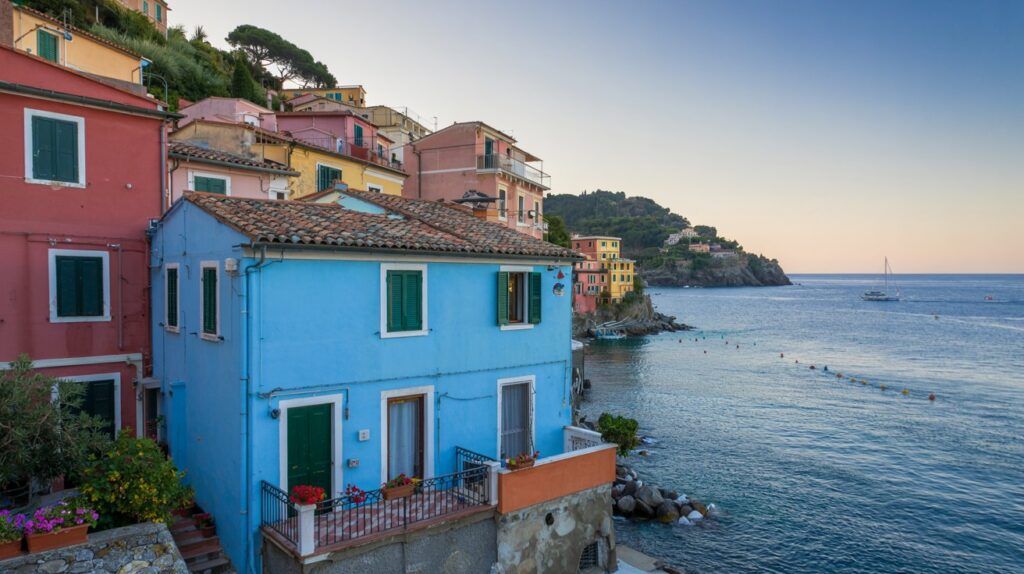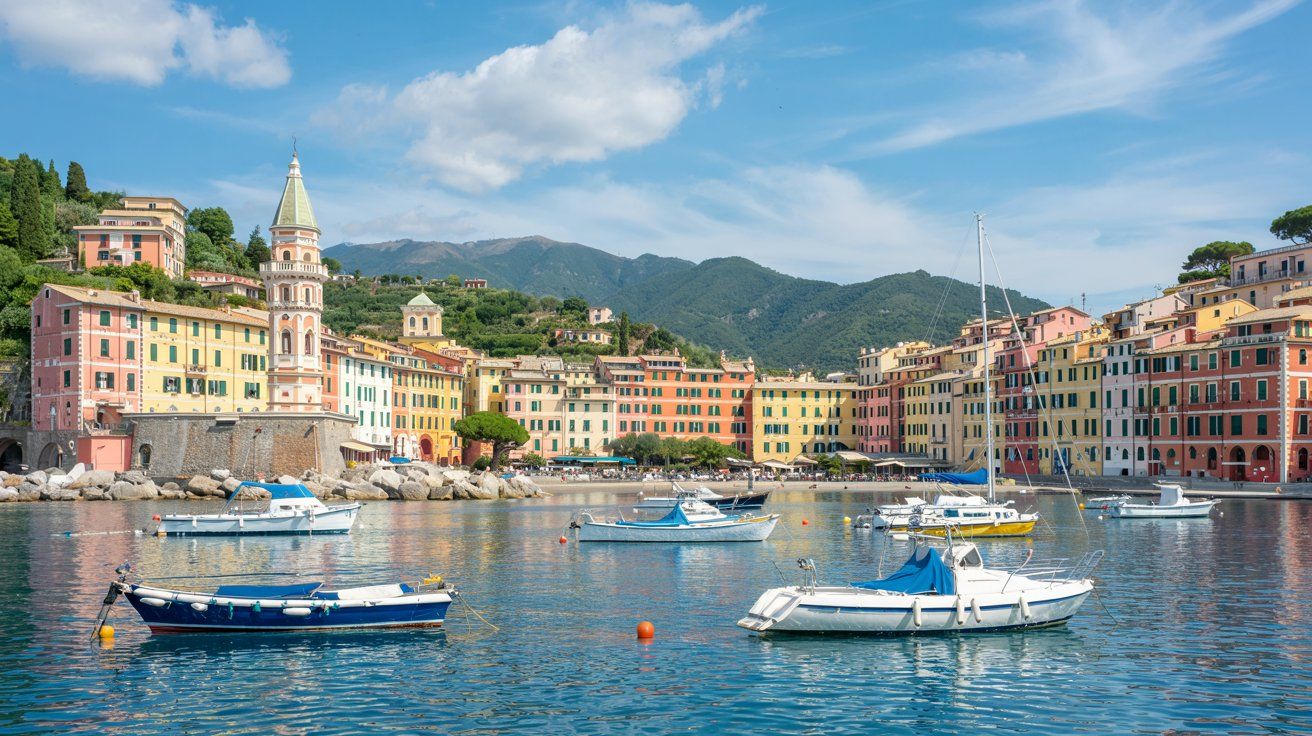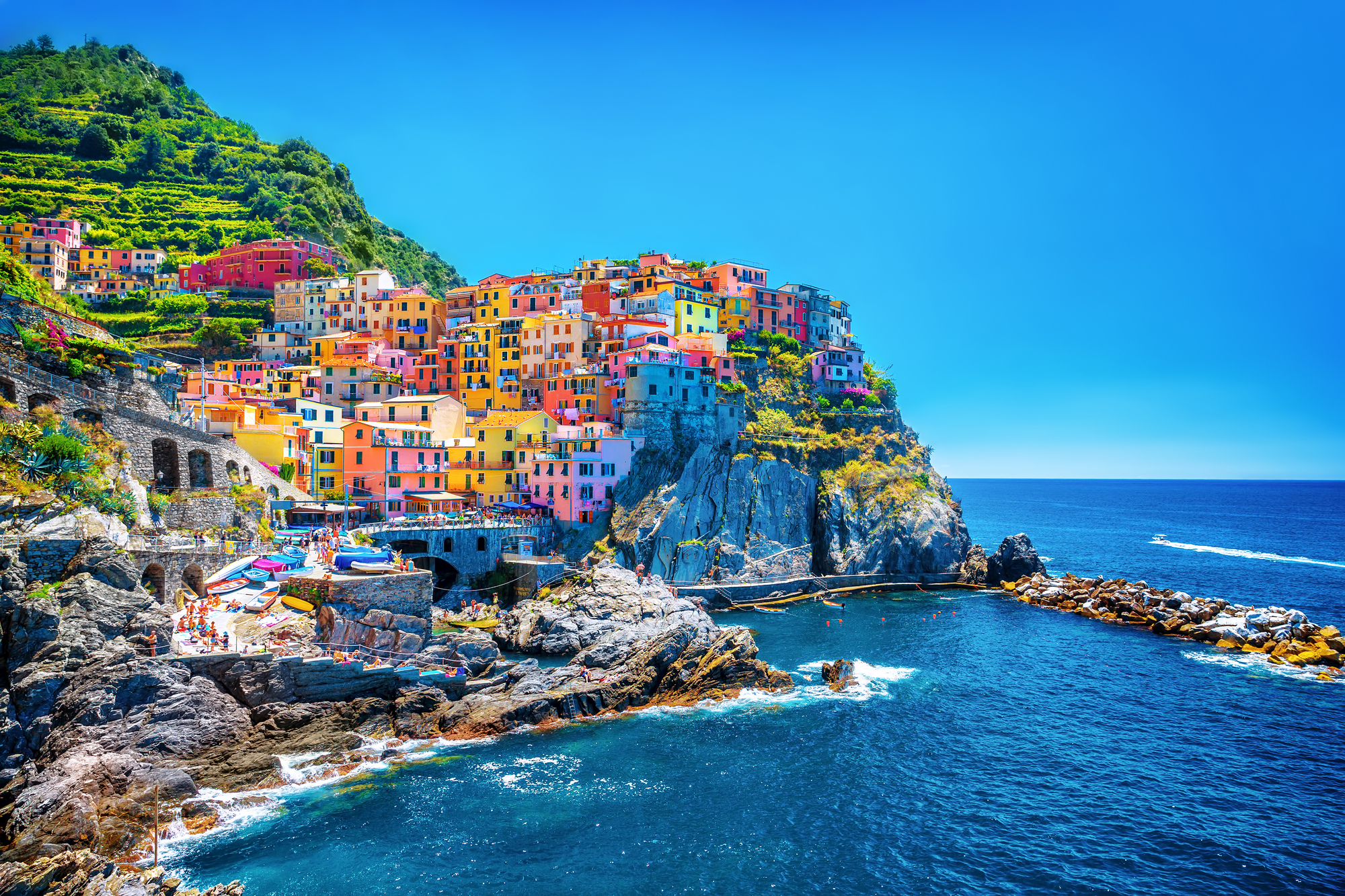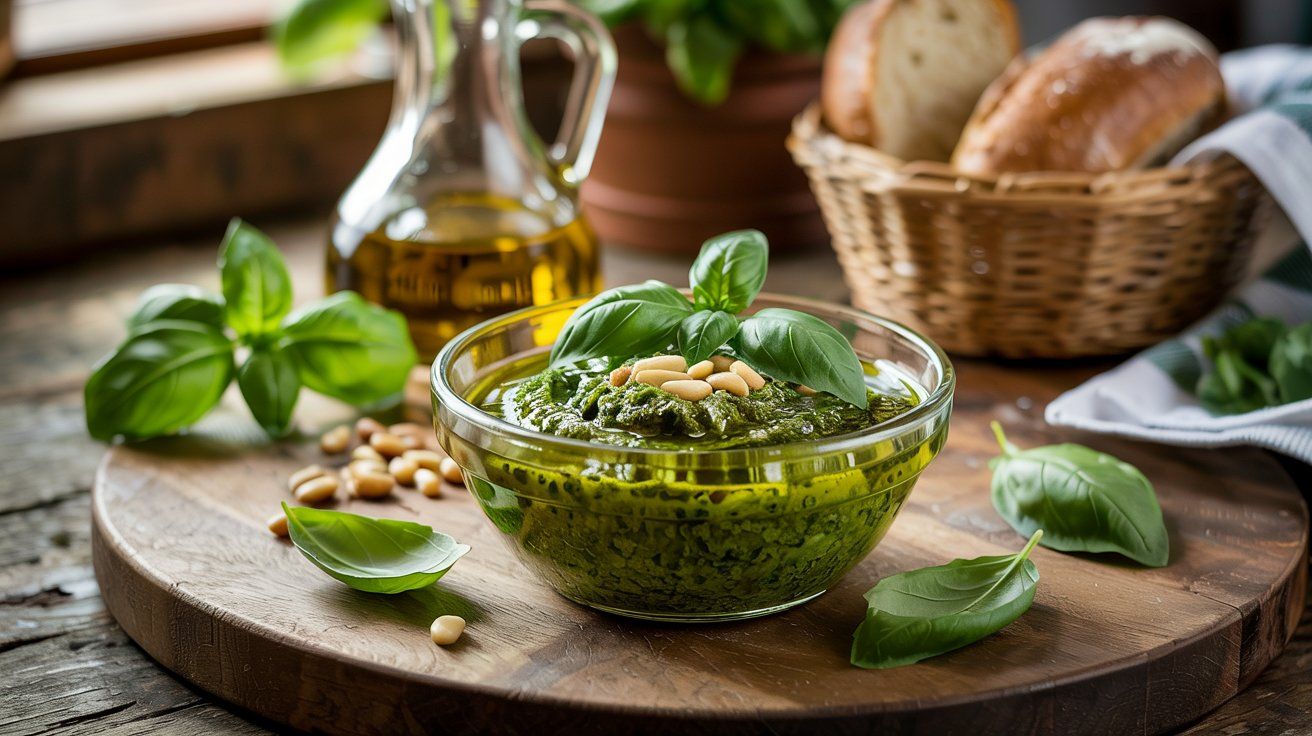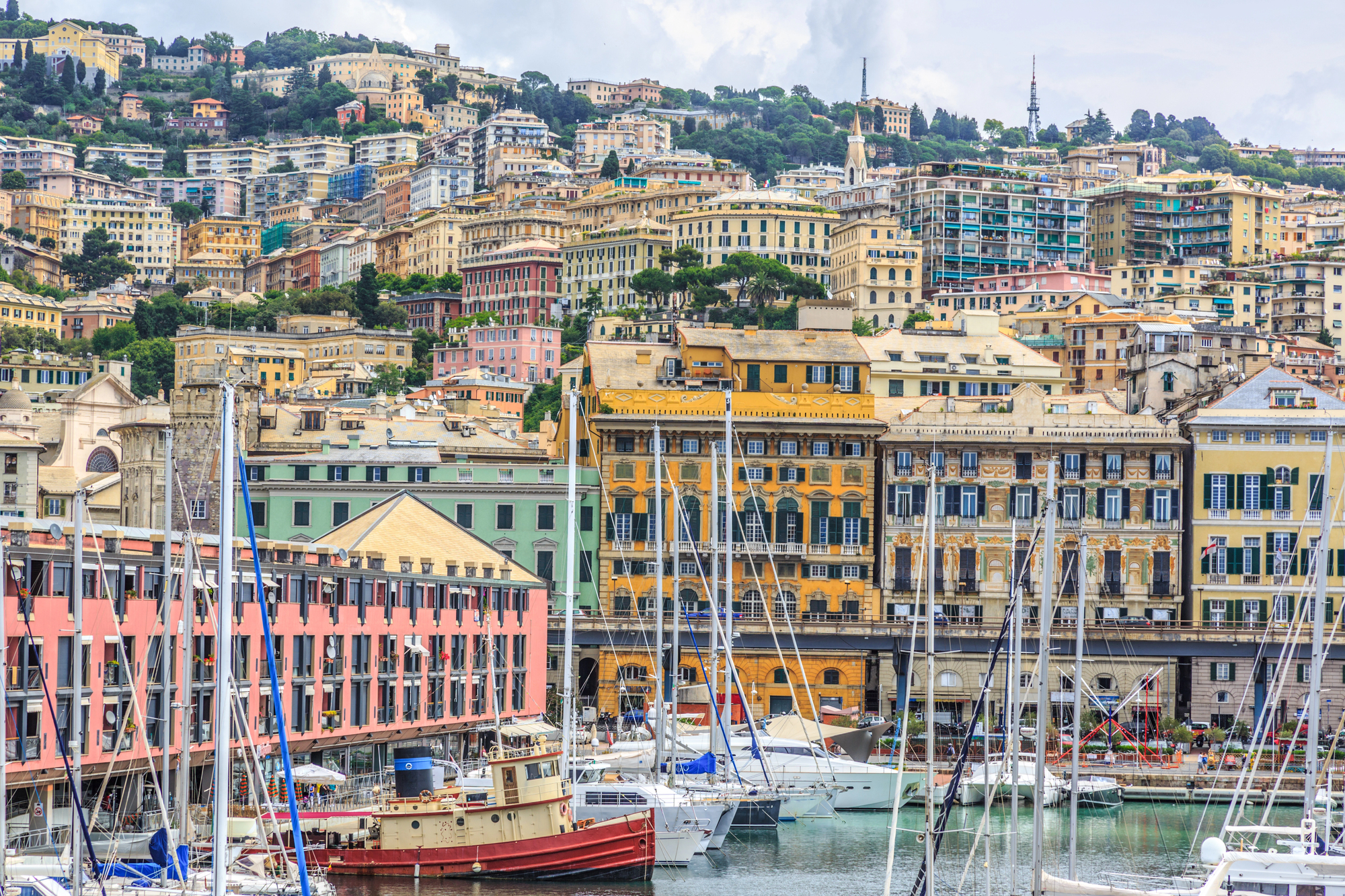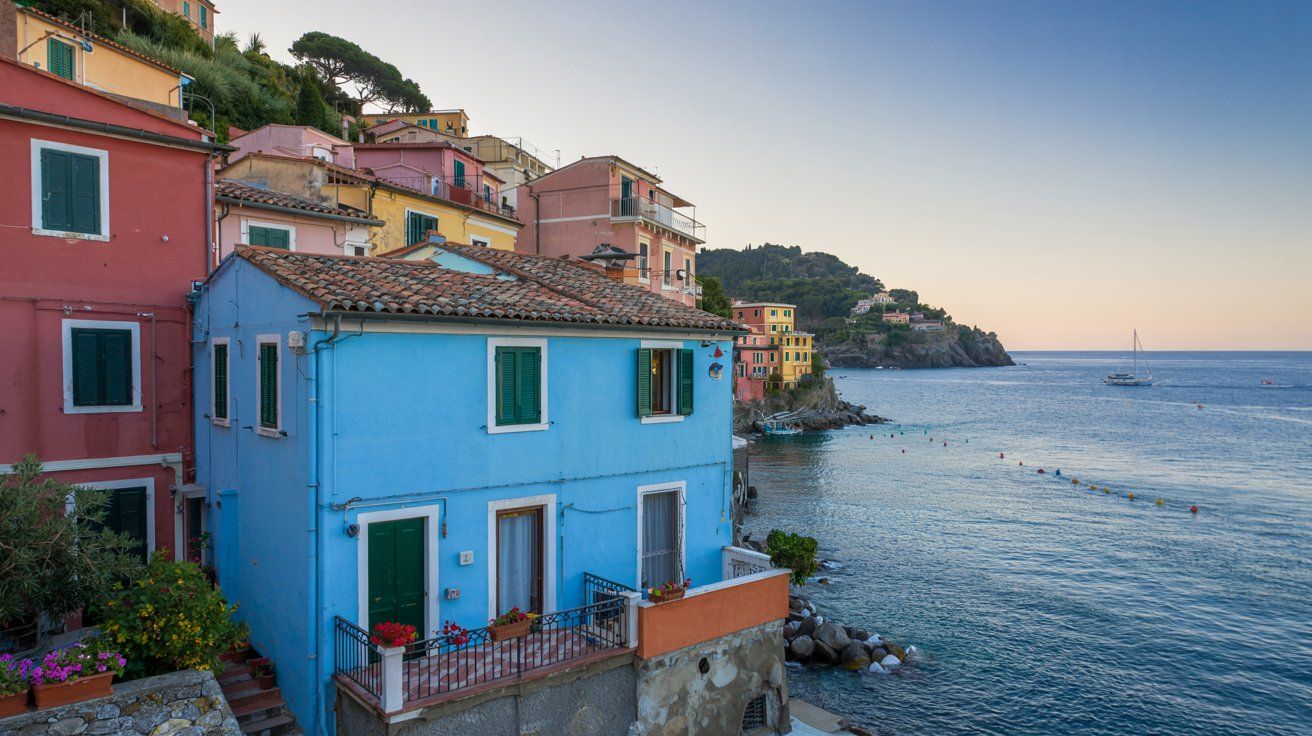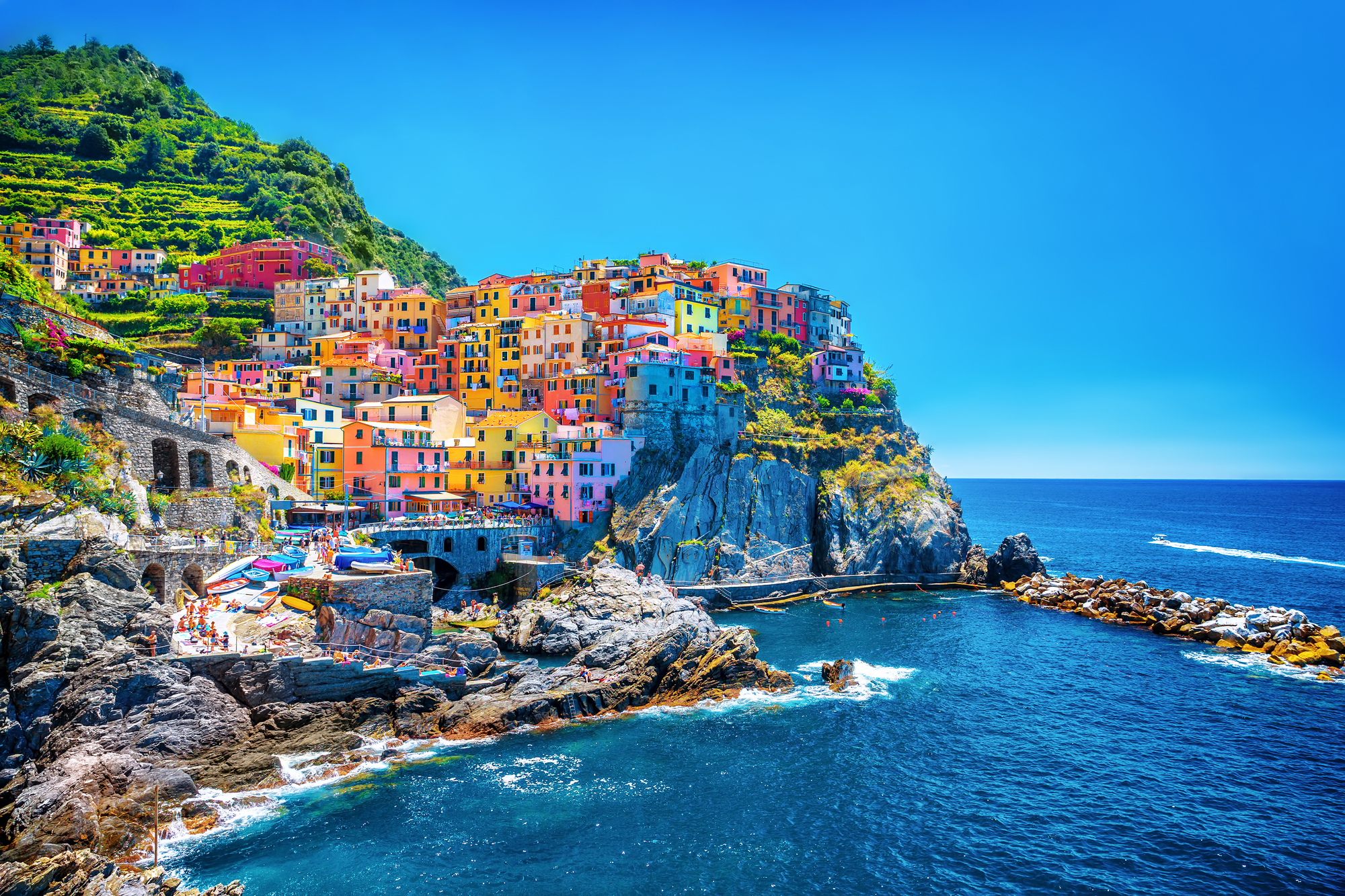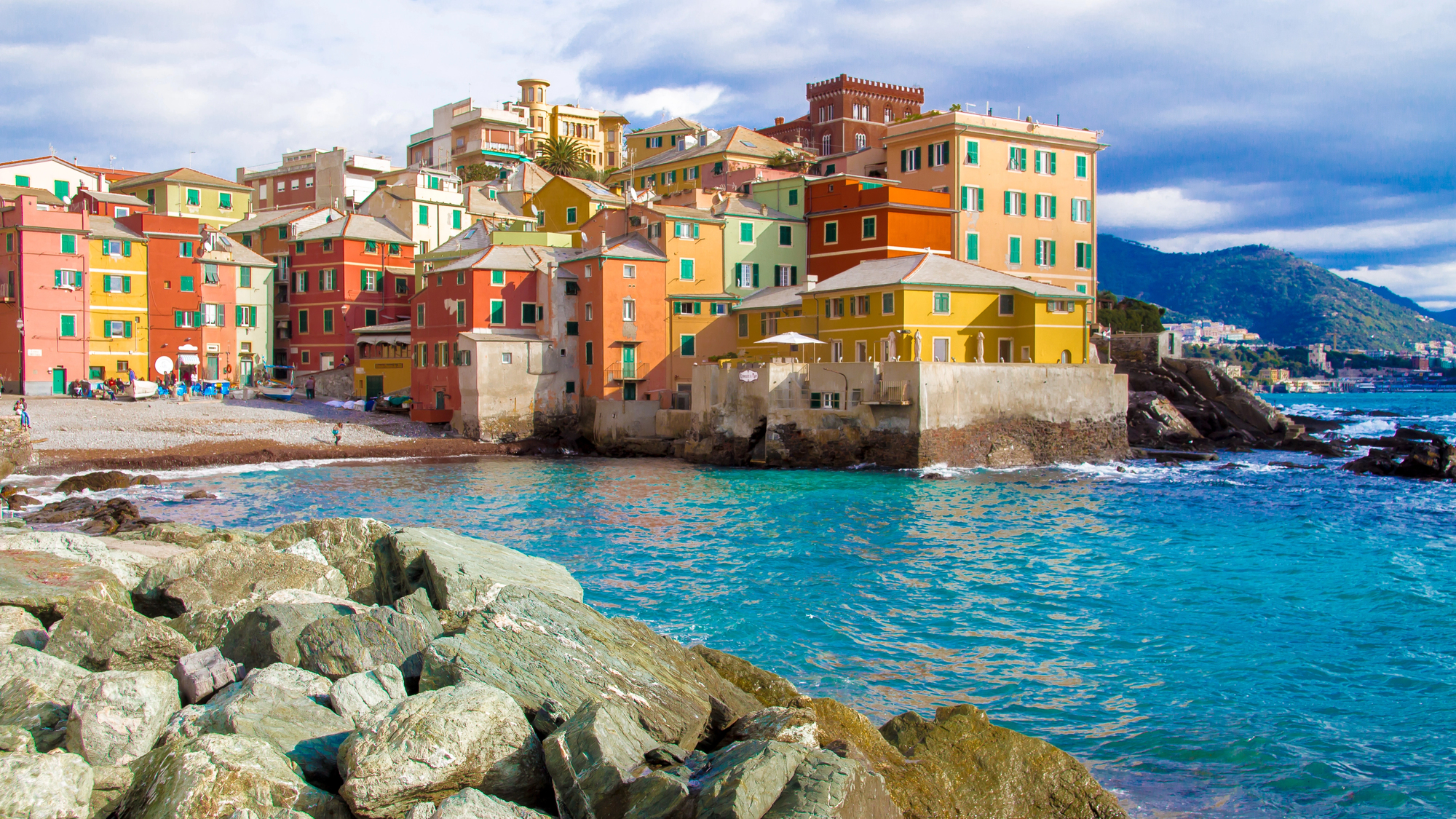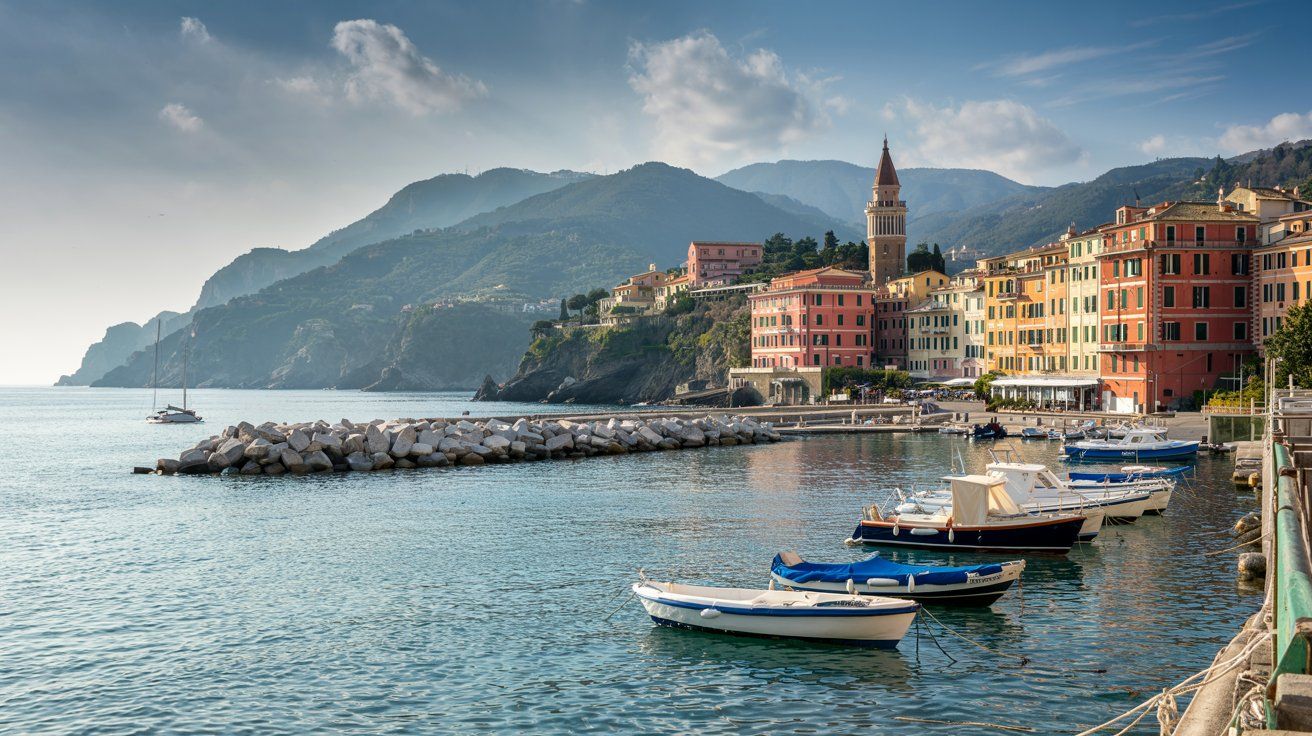The Italian Riviera awaits you with its sun-kissed beaches, colorful towns, and breathtaking views. This coastal gem enjoys over 300 days of sunshine yearly, making it a perfect destination for travelers seeking Mediterranean beauty. Visiting landmarks along the Italian Riviera offers you a unique blend of natural wonders, historical architecture, and authentic Italian culture that can’t be found anywhere else in the world.
When you explore this stunning coastline, you’ll discover rocky shores with hidden coves and graceful beaches nestled between rustic coastal towns. Each painted village tells its own story through vibrant colors and centuries-old buildings. The relaxed lifestyle is immediately noticeable as locals enjoy their daily routines against a backdrop of spectacular sea views.
Get a discount of 15% to 70% on accommodation in Genoa! Look for deals here:
Genoa Hotels, Apartments, B&Bs
Whether you visit during peak season or venture there during quieter times, the Italian Riviera’s landmarks remain impressive year-round. You can wander through charming streets, sample fresh seafood at local restaurants, and take in panoramic vistas that have inspired artists and writers for generations. The region’s rich history and natural beauty make every landmark worth your time and attention.
Things to Do in Riviera di Ponente Towns
| Things to Do in Riviera di Ponente Towns | ||
|---|---|---|
| Alassio | Albenga | Apricale |
| Arenzano | Arma di Taggia | Bergeggi |
| Bordighera | Bussana Vecchia | Celle Ligure |
| Cervo | Diano Marina | Dolceacqua |
| Finale Ligure | Finalborgo | Genoa |
| Imperia | Laigueglia | Loano |
| Noli | Pietra Ligure | Pigna |
| Rocchetta Nervina | San Lorenzo al Mare | Sanremo |
| Savona | Seborga | Triora |
| Varazze | Varigotti | Ventimiglia |
Things to Do in Riviera di Levante Towns
| Things to Do in Riviera di Levante Towns | ||
|---|---|---|
| Camogli | Chiavari | La Spezia |
| Lavagna | Lerici | Levanto |
| Moneglia | Portofino | Portovenere |
| Rapallo | Recco | San Fruttuoso |
| Santa Margherita Ligure | Sarzana | Sestri Levante |
| Tellaro | ||
Things to Do in Cinque Terre Towns
| Things to Do in Cinque Terre Towns | ||
|---|---|---|
| Cinque Terre | Corniglia | Manarola |
| Monterosso | Riomaggiore | Vernazza |
List of Main Attractions in the Italian Riviera
Things to Do in the Italian Riviera
Get a discount of 15% to 70% on accommodation in Genoa! Look for deals here:
Genoa Hotels, Apartments, B&Bs
The Italian Riviera stretches along the Ligurian coast and gives you this irresistible mix of natural beauty, culture, and pure relaxation. Whether you’re drawn to the colorful fishing villages of Cinque Terre or the chic seaside vibes of Santa Margherita Ligure and Portofino, this coastline just grabs your attention with its dramatic views and deep-rooted traditions. Some of the best things to do in the Italian Riviera? Hop on the train along the coast, dig into real Ligurian food, hike those cliffside trails, and wander through the charming villages with their quirky architecture and sun-soaked beaches.
You can pack your days with adventures or just take it slow. Hikers love the famous trails that link the five villages of Cinque Terre—honestly, the views are hard to beat. If you’d rather relax, you’ll find gorgeous beaches, local boutiques for a little shopping, and plenty of spots to sip wine while you stare out at the sea. There’s culture, too—the Aquarium of Genoa is a highlight, and those quirky trompe-l’oeil buildings in Santa Margherita Ligure always get a second look.
Overview of the Italian Riviera
The Italian Riviera really does blend colorful seaside towns, rugged cliffs, and that classic Mediterranean charm. Here, you get a little bit of everything: stunning nature, a food scene that’ll make you want to stay forever, and all kinds of outdoor fun.
Where Is the Italian Riviera Located?
You’ll find the Italian Riviera running along Italy’s northwest coast in Liguria. It curves from the French border at Ventimiglia all the way to the Tuscan edge near La Spezia. This narrow stretch squeezes between the blue Ligurian Sea and the mountains of the Maritime Alps and Apennines.
That geography? It creates a microclimate that’s just right for dramatic cliffs and lush scenery. The coast covers around 220 miles (350 km), so you can explore it in chunks and still get totally different experiences in each spot.
Most folks start their trip in Genoa, which splits the coast in half and acts as Liguria’s capital.
Climate and Best Times to Visit
The Italian Riviera has that classic Mediterranean weather—mild winters and warm, sunny summers. Even in winter, temperatures rarely dip below 50°F (10°C), and in summer you’re looking at a comfortable 77-86°F (25-30°C).
If you want to dodge the crowds and still get great weather, aim for April-June or September-October. Those shoulder seasons mean pleasant temps, fewer tourists, and better prices.
July and August? Expect heat and crowds, especially in hotspots like Riviera di Levante. In winter, things quiet down a lot—some places close, but you’ll save money.
Most of the rain falls in October and November. Swimming season runs late May through September, when the sea feels just right.
Distinct Regions and Towns
Genoa splits the Italian Riviera into two main slices: Riviera di Ponente (“coast of the setting sun“) to the west, and Riviera di Levante to the east.
The western Riviera di Ponente gives you wider beaches, laid-back resort towns like San Remo and Alassio, and usually lower prices. It’s famous for flowers, cycling, and a more relaxed vibe.
The eastern Riviera di Levante is home to the big names: Cinque Terre, Portofino, Santa Margherita Ligure. Here, you’ll see dramatic cliffs, bright fishing villages, and hiking trails with jaw-dropping views. The five Cinque Terre villages, all linked by paths, have become icons of the Italian coast.
Don’t skip Genoa itself. With its historic port, grand palaces, and authentic city life, it’s worth a wander.
Top Destinations in the Italian Riviera
The Italian Riviera is packed with must-see places, and each one has its own personality and reasons to fall in love with it.
Exploring Genoa
Genoa is Liguria’s lively capital and your main gateway to the Riviera. The city mixes medieval charm with modern energy. The Aquarium of Genoa, one of Europe’s largest, keeps kids (and honestly, adults) entertained with thousands of sea creatures.
Wander the historic center and you’ll get lost (in a good way) in a maze of “caruggi”—those narrow alleyways hide little restaurants, shops, and centuries-old buildings. The Palazzi dei Rolli, a collection of Renaissance palaces, are UNESCO-listed and seriously impressive.
Down by the water, the renovated waterfront makes for a lovely evening stroll. Genoa also has a bunch of museums—check out the Musei di Strada Nuova for art in some of the city’s grandest old houses.
Charming Santa Margherita Ligure
Santa Margherita Ligure strikes a nice balance between real Italian life and the comforts travelers want. Pastel buildings line the waterfront promenade, and honestly, it looks like a postcard.
The town is famous for its trompe-l’oeil art—those clever illusion paintings on building fronts that make you do a double-take. They give the center a playful, artsy vibe.
Walk down to the small harbor, where fishing boats and luxury yachts sit side by side. Seafood lovers can’t go wrong here; the Ligurian dishes, especially anything with pesto, are worth the trip.
Santa Margherita is also a smart base for exploring the area. Many travelers stay here and do day trips to busier spots like Portofino, which you can actually reach by a scenic walk along the coast.
Picturesque Portofino
Portofino is probably the most famous spot on the Italian Riviera. Once a humble fishing village, it’s now a luxury resort that draws celebrities and anyone chasing that glamorous harbor scene.
The heart of the village is its tiny harbor, ringed by candy-colored buildings—the kind you see on postcards and Instagram feeds everywhere. For a bit of history (and killer views), climb up to Castello Brown, a fortress perched above the sea.
You can walk here from Santa Margherita Ligure in about an hour, following a path through olive groves and past fancy villas. The views are gorgeous the whole way.
Portofino’s shops and restaurants do cost a bit more, but the atmosphere and scenery make it worth at least a day trip.
Discovering Camogli
Camogli feels like the Italian Riviera’s best-kept secret—an authentic fishing village that hasn’t been totally overrun. Its tall, narrow buildings, painted in warm tones, line up along the sea. Fishermen once painted them that way so they could spot their homes from the water.
Head to the pebbly beach for a swim with a backdrop of those colorful facades. If you’re around in May, don’t miss the Fish Festival (Sagra del Pesce), when locals fry up fish for thousands using massive pans.
From Camogli, you can hike out to San Fruttuoso, a remote abbey only reachable by foot or boat. The trail winds along the coast and through Portofino Regional Park, with plenty of Mediterranean greenery and sea views.
Camogli’s chill vibe and fair prices make it a great pick if you want to avoid the crowds.
Discovering Cinque Terre
Cinque Terre, or “Five Lands,” is a string of five bright fishing villages clinging to the wild Ligurian coast. Here, you get that perfect mix of natural beauty, local culture, and the chance to get outdoors.
Top Activities and Attractions
The Cinque Terre Travel Guide lists plenty of must-try experiences in each village. Every spot has its own distinct character.
Take a boat tour to see all five villages from the water—honestly, it’s a whole different perspective, and the way the houses cling to the cliffs is wild.
Sip local wine from the terraced vineyards that crawl up the hills. Sciacchetrà, a sweet dessert wine, is the regional specialty.
If you want a real beach day, head to Monterosso al Mare. It’s the biggest village and the only one with a true sandy beach.
Try your hand at a cooking class and learn to make Ligurian classics. Pesto, anchovies, and focaccia are all local stars.
Best Hiking Routes with Scenic Views
The Sentiero Azzurro (Blue Trail) links all five villages and serves up some of Italy’s most scenic views. Walking the whole thing takes about six hours, but you can easily pick a section or two.
The Via dell’Amore (Lover’s Path) between Riomaggiore and Manarola is the easiest stretch and definitely the most romantic. It hugs the cliffs, so bring your camera.
If you want more of a challenge, head up into the vineyards and olive groves for panoramic trails. The route from Vernazza to Monterosso is tough but totally worth it for the views.
Before you go, check which trails are open—sometimes landslides or repairs close sections. Good shoes and a bottle of water are a must for any Cinque Terre hike.
Seaside Villages and Coastal Experiences
The Italian Riviera is all about those coastal towns with their own personalities and killer Mediterranean views. Each village brings something different, from historic sights to sandy beaches that really show off what this region’s all about.
Rapallo’s Highlights
Rapallo makes a great base for exploring the Riviera. The town’s seafront promenade, lined with palms and colorful buildings, is perfect for a stroll.
Check out Castello sul Mare, the iconic castle on a tiny peninsula in the bay. Built in 1551 to keep out pirates, it now hosts art shows and offers some of the best views around.
On Thursdays, the waterfront fills with a lively market. You’ll find everything from local produce to souvenirs. For a little peace and a great view, hop on the cable car up to the Montallegro Sanctuary.
Rapallo keeps its authentic Italian charm while offering modern comforts. Grab a seat at a waterfront café, order focaccia or pesto, and watch the fishing boats drift by.
Savoring Sestri Levante
Sestri Levante sits on a slim peninsula between two bays: the Bay of Silence (Baia del Silenzio) and the Bay of Fables (Baia delle Favole), which got its name from Hans Christian Andersen’s brief stay.
The Bay of Silence has a curved beach lined with pastel houses. It’s a bit hidden and sheltered, making it a sweet spot for a swim or just chilling out.
Wander the historic center and you’ll find narrow alleyways (caruggi) leading to quiet squares and shops selling local treats.
On Saturday mornings, Piazza della Repubblica hosts a market with fresh produce, cheeses, and honey from nearby farms. For dinner, grab the catch of the day at a waterfront restaurant—seafood here is as fresh as it gets.
Relaxing at Local Beaches
The Italian Riviera gives you a mix of beaches, from soft sandy stretches to rugged rocky coves. You’ll find plenty of free public spots, but if you want a little more comfort, there are private beach clubs renting umbrellas and loungers.
Monterosso al Mare in Cinque Terre has the biggest sandy beach in the area. The water’s so clear you can see your toes, and the gentle slope makes it perfect for families. Grab a drink or a snack from one of the nearby bars—why not?
If you’re after peace and quiet, head over to the pebble beaches at Bonassola or Framura. These hidden gems offer calm swimming in turquoise water, and you won’t have to elbow your way through crowds.
Beach clubs go all out with restaurants, changing rooms, and gear for water sports. Lots of beaches connect to coastal paths, so you can wander along the Mediterranean at sunset—pretty magical, honestly.
Most people swim from May through September when the water feels just right. If you want some space and cooler air, try showing up early in the morning.
Cultural and Historical Sites
The Italian Riviera isn’t just about the views—it also packs in centuries of history and culture. You’ll stumble upon ancient abbeys, secret treasures, and museums that really let you peek into the region’s past.
Visiting the Abbey of San Fruttuoso
You’ll find the Abbey of San Fruttuoso tucked away in a cove between Camogli and Portofino. Built in the 10th century, this Benedictine monastery only reveals itself to those who arrive by boat or hike in, which makes it feel a bit mysterious.
Its stone walls, unique dome, and arched porticoes show off its medieval roots. Inside, you can wander a small museum filled with relics from the abbey’s long story.
Just below, divers flock to see the Christ of the Abyss—a bronze statue placed underwater in 1954 to watch over fishermen and sailors.
In summer, the tiny beach in front of the abbey gets busy fast, so if you’re visiting between June and August, try to beat the rush.
San Fruttuoso: Hidden Gem
San Fruttuoso isn’t just about its abbey. The tiny village itself lets you slow down and escape the buzz of bigger Riviera towns. A handful of restaurants serve up seafood caught that morning by local fishermen.
The bay, protected and calm, is perfect for a swim. Even in peak season, you’ll notice it stays quieter than Cinque Terre’s famous villages.
If you love hiking, take the trail from Portofino to San Fruttuoso. It twists through Mediterranean brush and gives you those jaw-dropping sea views.
Places like San Fruttuoso are hiding all over the Italian Riviera Landmarks, waiting for travelers who want to explore beyond the obvious.
Museums and Local Heritage
Genoa claims the title of cultural capital here, and honestly, it earns it. The Musei di Strada Nuova brings together three grand palaces packed with European art.
At Palazzo Reale, you can wander royal apartments—original furniture, paintings, sculptures, and a Hall of Mirrors that rivals Versailles, just on a more manageable scale.
The Galata Maritime Museum brings Genoa’s seafaring story to life with hands-on exhibits and tales of Christopher Columbus.
In smaller coastal towns, folk museums and cultural centers keep traditions alive. You’ll see fishing gear, lacemaking tools, and everyday artifacts from life on the Ligurian coast.
If you’re into art, don’t skip the region’s many churches. Some real Italian masterpieces are tucked away inside.
Outdoor Adventures and Activities
The Italian Riviera delivers when it comes to outdoor fun, whether you want to hike along the coast or dive into the Mediterranean.
Walking and Hiking Along the Riviera
Some of Italy’s best hiking trails wind through the Riviera. The Sentiero Azzurro (Blue Trail) links all five Cinque Terre villages, hugging the cliffs above the sea. You’ll find everything from easy strolls to tougher hikes.
Trail 2, between Monterosso and Vernazza, draws a crowd thanks to its views. It’s about two miles and takes around two hours—plenty of time to soak in the terraced vineyards and endless blue water.
If you’d rather skip the crowds, check out the paths around Portofino or the trails of Portovenere. Most trails are well-marked, but trust me, good shoes are a must.
Boat Tours and Water Sports
The Riviera’s Mediterranean waters make it a playground for water lovers. Boat tours give you a fresh angle on those colorful villages.
From Genoa, Santa Margherita, or La Spezia, you can hop on a scheduled boat trip or even charter your own. Many tours stop at secret coves you can’t reach by land—always a bonus.
Popular water sports? Take your pick:
- Kayak around rocky inlets
- Snorkel in the clear sea
- Try stand-up paddleboarding along gentle bays
- Go scuba diving and meet the local marine life
Late spring to early fall is prime time, with warm, calm seas. Most coastal towns rent out gear and offer beginner lessons, so you don’t need to be an expert.
Gastronomy and Local Cuisine
Food on the Italian Riviera? It’s all about fresh ingredients and simple, honest flavors. Genoa’s culinary traditions meet seaside specialties, and every town seems to have its own twist.
Liguria’s Culinary Delights
Ligurian cuisine really leans into what the land and sea provide. Cuisine of the Italian Riviera uses olive oil instead of butter—makes everything lighter. Pesto Genovese is the superstar: basil, pine nuts, garlic, Parmigiano-Reggiano, and olive oil blended into something magical.
Focaccia is everywhere. In Genoa, try the classic version—just olive oil and salt, simple and addictive. Or head to Recco for Manuelina’s focaccia al formaggio, which oozes with creamy cheese.
Pasta fans will love the local shapes like trofie (twisted) and trenette (flat), both made for pesto. Farinata, a chickpea pancake, is perfect street food when you’re exploring.
Seafood and Farmers’ Markets
Being right on the coast, the Riviera serves up some seriously good seafood. In Camogli, the Fish Festival every May draws crowds with giant pans frying up the day’s catch.
For a taste of real Liguria, wander through the Friday markets in coastal towns. You’ll spot heaps of fresh produce, cheeses, and seafood. Monterosso’s anchovies, just dressed with lemon and olive oil, are a local favorite.
Try dishes like ciuppin (fish stew) or burrida (seafood with walnut sauce) for something different. And if you want to taste it all, join a food tour in Genoa to sample traditional treats as you wander the city’s old arcades and food shops.
Festivals and Events
The Italian Riviera loves a good celebration. Its festivals bring together food, music, and tradition all year long. Whether it’s seaside fish festivals or historic events, you’ll get a real taste of local life.
Seasonal Celebrations
Carnevale takes over the Riviera in February, with masked parades and pastries filling the streets—Venice might be most famous, but the local vibe here is special.
Summer is all about food festivals. The Sagra del Pesce (Fish Festival) stands out, with locals cooking up seafood feasts in the main squares. You can sample fish fresh from the sea, cooked the Ligurian way.
Wine lovers should look out for Sagralea, the big “Sagra del Vino Pigato” festival. It’s all about the region’s unique white wine, with tastings and chances to chat with local winemakers.
Local Traditions and Public Events
At Christmas, the Presepe di Pentema transforms an entire village into a living nativity scene, complete with costumes and hand-built settings—honestly, it’s a sight you won’t forget.
Beach towns light up in summer with outdoor concerts and film nights, usually kicking off in the cooler evenings and carrying on late.
Many towns keep up old religious processions for their patron saints. These candlelit walks, with people carrying ornate statues and singing, really capture the Riviera’s spirit.
If you’re into sports, the Fisiko! events make the most of the landscape, offering everything from swimming to rock climbing along the dramatic coast.
Travel Tips and Practical Information
Planning a trip to the Italian Riviera means figuring out how you’ll get around and making the most of your time. There are plenty of ways to explore these coastal towns.
Getting Around the Riviera
Trains are hands-down the easiest way to travel the Riviera. Regional trains connect most towns, run often, and won’t break the bank. Just grab tickets at the station or use the Trenitalia app before you board.
Buses fill in the gaps, especially for smaller villages where trains don’t reach. If you want more freedom, you can rent a car—but parking is tough and pricey in popular spots, especially in summer.
Ferries run from April to October and make for a pretty scenic ride between places like Portofino, Santa Margherita Ligure, and the Cinque Terre.
Most historic town centers are closed to cars, so you’ll end up walking a lot. Pack decent shoes—the hills can catch you off guard.
Suggested Itineraries
3-Day Trip:
- Day 1: Dive into Genoa’s historic center and check out the aquarium.
- Day 2: Head over to Santa Margherita Ligure, then stroll along the coast to Portofino.
- Day 3: Hop on a train for a day trip—pick two Cinque Terre villages and soak it in.
Week-Long Visit:
- Spend your first 2 days wandering Genoa.
- Set up base in Rapallo or Santa Margherita for 3 nights.
- Use 2 days to explore the Cinque Terre villages at your own pace.
- Swing by towns like Camogli or Portovenere if you want something a little off the radar.
If you’re coming for the first time, Santa Margherita Ligure just makes things easier. It sits right in the middle of everything and has solid transport links, so you can get to Portofino or the Cinque Terre without much hassle—definitely simpler than staying in Genoa.
Honestly, spring (April-May) or fall (September-October) feel like the sweet spot. You get mild weather, the crowds haven’t taken over, and prices don’t make your wallet cry. Those shoulder seasons really let you explore without feeling rushed or packed in.
Get a discount of 15% to 70% on accommodation in Genoa! Look for deals here:
Genoa Hotels, Apartments, B&Bs

